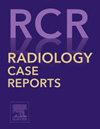Multisystemic impact of autosomal dominant polycystic kidney disease: A case report highlighting renal, hepatic, and neurological involvement
Q4 Medicine
引用次数: 0
Abstract
We present a case of a 64-year-old male with Autosomal Dominant Polycystic Kidney Disease (ADPKD), characterized by systemic involvement, including renal, hepatic, and neurological complications. The patient presented with persistent micturition difficulties, hematuria, and abdominal pain, compounded by hypertension and chronic obstructive pulmonary disease. Imaging revealed bilateral renal enlargement with hemorrhagic cysts, a kidney stone, and hepatic cysts causing hepatomegaly. Neurological evaluation identified chronic and recent intracerebral hemorrhages associated with poorly controlled hypertension, underscoring ADPKD's multisystem impact. ADPKD, caused by PKD1 or PKD2 mutations, often leads to progressive renal dysfunction, hypertension, and extrarenal manifestations such as hepatic cysts and intracranial aneurysms. Advances like tolvaptan demonstrate efficacy in slowing renal disease progression, while somatostatin analogs offer promise for hepatic cyst management. This case emphasizes the necessity of a multidisciplinary approach, including strict blood pressure control, regular imaging, and pharmacological intervention, to address ADPKD's complexities and optimize patient outcomes. Early diagnosis and vigilant monitoring remain crucial for preventing complications and enhancing quality of life. This report underscores the importance of integrated care in managing ADPKD, highlighting emerging therapies and the ongoing need for personalized treatment strategies in such challenging cases.
求助全文
约1分钟内获得全文
求助全文
来源期刊

Radiology Case Reports
Medicine-Radiology, Nuclear Medicine and Imaging
CiteScore
1.10
自引率
0.00%
发文量
1074
审稿时长
30 days
期刊介绍:
The content of this journal is exclusively case reports that feature diagnostic imaging. Categories in which case reports can be placed include the musculoskeletal system, spine, central nervous system, head and neck, cardiovascular, chest, gastrointestinal, genitourinary, multisystem, pediatric, emergency, women''s imaging, oncologic, normal variants, medical devices, foreign bodies, interventional radiology, nuclear medicine, molecular imaging, ultrasonography, imaging artifacts, forensic, anthropological, and medical-legal. Articles must be well-documented and include a review of the appropriate literature.
 求助内容:
求助内容: 应助结果提醒方式:
应助结果提醒方式:


